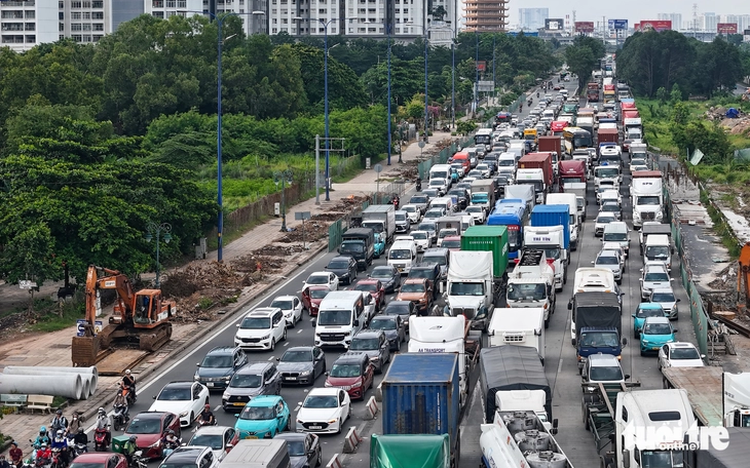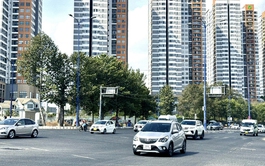
Ho Chi Minh City is developing two dedicated bicycle lanes along Mai Chi Tho Boulevard. Photo: Chau Tuan / Tuoi Tre
As a result, only one pilot project is currently underway on Mai Chi Tho Boulevard, according to the municipal Department of Construction.
Speaking during the city's socio-economic press conference on Thursday, Nguyen Kien Giang, deputy head of the traffic works maintenance and operation management division under the Department of Construction, outlined the situation in detail.
National technical standards permit bicycle lanes to be located either on sidewalks shared with pedestrians or within roadways, but they must meet specific technical requirements. The minimum width for a standard bicycle lane is 2.5 meters.
However, many streets in Ho Chi Minh City, especially in the downtown area, do not meet these criteria.
Roads like Pham Ngu Lao, Ly Tu Trong, and Nam Ky Khoi Nghia have sidewalks that are both narrow and uneven.
These sidewalks are often obstructed by parked motorbikes, informal vendors, utility poles, electrical boxes, and light fixtures.
In many cases, the remaining pedestrian space fails to reach even the 1.5-meter minimum width.
In terms of the roadways, most streets are also too narrow and suffer from heavy congestion.
These conditions make it difficult to dedicate space for separate bicycle lanes without significantly disrupting traffic.
Giang said that while bicycle lanes were considered more than ten years ago, with roughly 20 routes reviewed, only one has moved forward as a pilot.
The lack of progress is due in part to public concerns about worsening congestion and the difficulty of even accommodating motorbikes in many areas.
Currently, the Urban Traffic Management Center is constructing two bicycle lanes along the sidewalks of Mai Chi Tho Boulevard, stretching from Nguyen Co Thach to D1 Street.
The project spans approximately six kilometers in both directions. The lanes will feature clear markings and dedicated signs to distinguish them from lanes for cars and motorbikes.
Public bicycle stations and parking zones will be added near residential neighborhoods, including Sala Urban Area and The New City.
Construction is expected to begin this month and be completed within three months, with the new lanes becoming operational by December 2025.
After the pilot program, the Department of Construction will continue observing and evaluating its effectiveness while conducting further research for possible expansion to other areas.
Prior to July's administrative merger with Binh Duong and Ba Ria-Vung Tau Provinces, Ho Chi Minh City had 4,869 roads with widths of five meters or more.
However, more than half of those streets lacked sidewalks altogether.
This reality, combined with narrow walkways and frequent traffic jams, makes the development of safe and separate bicycle lanes a complex challenge.



Max: 1500 characters
There are no comments yet. Be the first to comment.